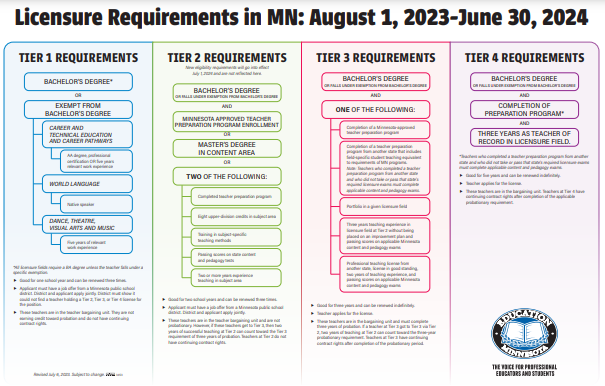Teacher Licensure in Minnesota
Attaining a Minnesota Teaching License is a requirement for teaching in Minnesota public schools. The Minnesota Professional Educator Licensing and Standards Board, PELSB, is the state agency that oversees teacher licensing. Minnesota offers a variety of licenses for practicing teachers, new teachers, and those with experience teaching outside of Minnesota. This article identifies essential resources for your initial or renewal application.
A great visual to start with is this Tiered licensure Infographic created by Education Minnesota, the union representing over 70,000 PreK-12 teachers and school support professionals in Minnesota.

Current educators review their credentials using the Minnesota teaching license lookup directly on the PELSB website.
Jump to: how to become a substitute teacher or MN licensing for out-of-state candidates.
Achieving Minnesota Teacher Certification
Minnesota offers a four-level educator licensure system, depending on factors like education, experience, test scores, and evaluation. Most educators in Minnesota need at least a bachelor’s degree. Tier 1 and 2 licenses tie to the hiring district or charter school, but Tier 3 and 4 licenses are portable, giving you more flexibility in employment.
Tier 1 licenses are for niche classes and hard-to-fill positions. The license is good for only one year and requires a job offer. I.e., you first apply and get a job offer, then apply for the license with the support of the hiring school. A bachelor’s degree typically required with a Tier 1 license, but not always. The exceptions to the bachelor’s degree requirement for a Tier 1 license are for career and technical educators, native speakers of world languages, dance, theatre, visual arts, and music teachers may all receive a Tier 1 license to teach in Minnesota.
Tier 2 licenses are available to those that would qualify for a Tier 1 license, or have a bachelor’s degree. The license is good for two years and, like Tier 1, requires a job offer.
Most new teachers start at Tier 3 after completing an approved teacher preparation program. Tier 3 licenses are good for three years and can be renewed indefinitely.
Tier 4 can be attained with classroom experience and need to be renewed every five years.
The licensing process with PELSB takes about two to five weeks on average.
Other scenarios:
Short Call Substitute License
To work as a substitute teacher in Minnesota, you must first obtain a substitute teaching license from PELSB, a “short call” license. This license allows for teaching on a day-to-day basis, at most 20 consecutive days, replacing the same teacher. The license is valid for functioning as a short-call substitute teacher at all grade levels in all teaching fields.
NOTE: You often see postings for “long-term substitute” teaching positions. These positions are for more than 20 consecutive days and require a full Minnesota teaching license or permission valid for the assignment.
To attain a short call license, you must meet at least one of the following criteria:
- Hold a minimum of a bachelor’s degree from an accredited college or university, as verified by a college transcript.
- Hold a credential outside the United States equivalent to a bachelor’s degree.
- Applicants in career and technical education fields have either five years of relevant work experience aligned with the assignment, or an associate’s degree aligned with the assignment, or a professional certification aligned to the assignment.
- Be enrolled, make meaningful progress in a PELSB-approved teacher preparation program, and successfully complete student teaching.
2023 – 2025 Substitute Teaching Pilot
The 2023 Minnesota Legislature authorized a new pilot program, which expands the eligibility requirements to serve as a short-call substitute teacher in a public school in Minnesota. A short-call substitute can replace a teacher of record or fill a vacancy for up to 20 consecutive school days.
The following individuals are now eligible to apply for short call substitute license under this pilot program:
- Individuals who hold an associate’s degree in any field or
- Educational support professionals (paraprofessionals) that hold a high school diploma or equivalent and have worked for at least one year for the hiring school.
This pilot requires cooperation from the school employer. Only some schools will participate, but those who do must pay a rate of at least $200 per day. More information on the PELSB website.
Out-of-State Teachers
If you’ve been teaching in another state or have completed your teacher preparation outside of Minnesota, you will likely qualify for a Minnesota teacher license under the tiered licensure structure.
Most out-of-state candidates apply for either a Tier 2 or Tier 3 license. Get started at PELSB’s Apply for a License webpage.

